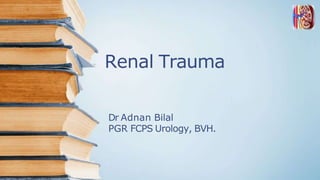
Renal Trauma | Diagnosis, Management and Followup
- 1. Renal Trauma Dr Adnan Bilal PGR FCPS Urology, BVH.
- 2. Contents • Definition & Epidemiology • Anatomy • Etiology • Pathology & Classification • Clinical Findings • Investigations • Management • Follow up • Complications
- 3. Definition & Epidemiology • Renal Trauma is physical injury or wound to renal parenchyma cause by intentional or unintentional extrinsic agent. o Renal trauma is present in to up 5 %of all trauma cases. o Renal injuries are the most common injuries of the urinary system. o M:F =3:1
- 4. Anatomy • Kidneys are retroperitoneal structures surrounded by perirenal fat, the vertebral column and spinal muscles, the lower ribs, and abdominal contents. • Children are more prone to injurybecause of the relatively greater size of the kidneys in children, the smaller protective muscle mass and cushion of perirenal fat, and the more pliable rib cage.
- 5. Key Points • Eliciting a detailed history of the trauma • Initial resuscitation according to ATLS guidelines • Early imaging and diagnosis • Conservative management unless the patient is unstable • Awareness of complications
- 7. ( Rapid acceleration or deceleration) • Blast Injuries (Low / High Velocity)
- 10. AAST Organ InjurySeverity Scale AAST Organ Injury Severity Scale
- 16. Clinical Presentation • Hematuria (defined as >5erythrocytes per HPF or dipstick positive) – Blunt injury: Indicates significant renal injury – Penetrating injury: May be absent • Bruising in the flank / Seat belt marks • Diffuse abdominal tenderness • Penetrating Chest / Abdominal wounds • Hypovolemic Shock
- 17. Diagnostic Evaluation • History and Physical Examination • Laboratory evaluation • Imaging
- 20. Imaging
- 21. Imaging
- 22. Imaging Modalities • Ultrasound (FAST) • IVU • CECT Scan –Modality of Choice • MRI
- 23. Ultrasound (FAST) • First imaging modality. • Can identify – Presence of Two Kidneys – Renal vessel blood flow – Retroperitoneal hematoma • Cant identify – Small Parenchymal tears – Collecting system injuries – Extravasation of urine in early phase • Good for follow up of stable renal injury patients
- 25. Intravenous pyelography (IVU) • Replaced by contrast- enhanced CT scan as the imaging study of choice in patients with suspected renal trauma. • Hemodynamic instability precludes Imaging. • Indications: a) Retroperitoneal hematoma b) Renal injury likely to require nephrectomy Procedure: A single shot X ray istaken 10 min after contrast administration (2ml /KG )
- 26. CECT • Imaging modality of choice in hemodynamically stable patients following blunt or penetrating trauma. • Look for: – Depth of parenchymal laceration – Parenchymal enhancement – Urinary extravasation – Presence, size and position of retroperitoneal hematoma – Adjacent organ injuries – Presence of contralateral normal kidney
- 27. Grade 1
- 28. Grade 2
- 29. Grade 3
- 30. Grade 4
- 31. Grade 5
- 32. Management • Non Operative Most blunt (95%) and many penetrating renal injuries (50% of stab injuries and 25% of gunshot wounds) can be managed non- operatively. – Conservative – Interventional Radiology – Embolization (All grades) • Operative
- 34. Selective angioembolization is used for active renal bleeding if there are no other indications for immediate surgical exploration.
- 38. Operative Approach • Exploration through a midline incision is preferred. • Assess life-threatening bleeding, which is controlled with direct pressure or packed to stabilize the critically ill patient. • Assess and control hemorrhage from the liver, spleen, and major retroperitoneal vessels prior to exposing the kidney. • Ifstabilized with these maneuvers, consideration should be made to leaving the perinephric space undisturbed. • Explored if the hematoma is expanding or pulsatile, or if there is suspicion of penetrating renal injury.
- 39. Procedure • Transverse colon and small bowel are retracted cephalad and to the right to expose the root of the mesentery. • Vascular control prior to exploring the likelihood that nephrectomy. • An incision is made in the retroperitoneum over the aorta from the level of the inferiormesenteric artery to the ligament of Treitz . If retroperitoneal hemorrhage obscures the aorta, incision is made medial to the inferior mesenteric vein, which is readily identifiable in the mesentery. • The renal artery to the kidney of kidney has been shown to minimizethe • interest may be controlled as it exits the aorta (inset). The left renal vein coursing anterior to the aorta isthe landmark. Sweeping the duodenum off the vena cava facilitates identification of the right renal artery. • The artery and vein on the side of interest are isolated with vessel loops but not clamped unless bleeding is uncontrollable.
- 41. Procedure • The colon is then reflected medially by incising the line of Toldt • Rapid blunt dissection exposes the kidney and surrounding hematoma. • Ifbrisk bleeding ensues, the previously isolated vessels may be clamped or secured with Rummel tourniquets.
- 45. Partial vessel Injury Repair
- 47. -(May eventually require nephrectomy)
- 48. o Loss of Kidney Function